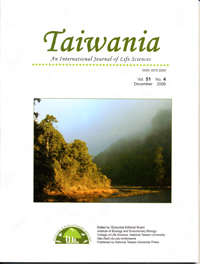Research Paper
Climatic Characteristics of the Subtropical Mountainous Cloud Forest at the Yuanyang Lake Long-Term Ecological Research Site, Taiwan
I-Ling Lai, Shih-Chieh Chang, Po-Hsiung Lin, Chang-Hung Chou and Jiunn-Tzong Wu
Published on: December 2006
Page: 317 - 329
DOI: 10.6165/tai.2006.51(4).317
Abstract
To better understand the climatic characteristics in a subtropical mountainous cloud forest at the Yuanyang Lake long-term ecological research site, weather data collected from January 1994 to December 2004 were analyzed in the present study. The obvious seasonal changes in climatic factors were observed at this site. The annual mean air temperature was 12.7°C. The lowest temperature was recorded in February (monthly mean 5.9°C), and the highest one was taken in July (monthly mean 18.1°C). Winter featured light rain with a prolonged occurrence of fog, resulting in a large reduction of radiation. In summer, fog occurred once in the early morning and the other time from afternoon to evening. The latter one was associated with the wind direction changes and usually accompanied with short moderate to heavy convective rain. Consequently the photosynthetic photon flux density (PPFD) was high in the morning but reduced drastically in the afternoon. Typhoons occurred in the summer had contributed to 37% of the annual rainfall, usually resulting in torrential rain events and sharp increases in the water level of this lake. As a matter of fact, perhumid environment of this site was attributed to abundant rainfall (mean annual precipitation 3396 mm) and high frequency (up to 40%) of foggy time. Such conditions would reduce the intensity of solar radiation and PPFD. The average annual solar radiation at the site was 2475 MJ m-2, and annual PPFD was 5713 mol m-2. The average degree of reduction of PPFD under foggy condition was up to 88%. Such climatic characteristics are suggested to constrain the growth of plants and play an important role in competition among plant species in this cloud forest. It is considered that the distinct seasonal fluctuation in environmental factors, perhumid and dim light conditions are the most distinguished characteristics of this subtropical mountainous cloud forest ecosystem.
中文摘要
本研究藉由分析1994 年一月至2004 年十二月在臺灣鴛鴦湖(YYL)長期生態研究區 收集的氣象資料以瞭解本地亞熱帶雲霧林之氣候特徵。結果顯示此地的氣候具有明顯的 季節性,並且深受東亞季風的影響;年均溫12.7°C,二月最冷月均溫為5.9°C,七月最 暖月均溫為18.1°C。冬季長時間籠罩在細雨與雲霧下,夏季則呈現明顯的日夜週期變 化。夏季清晨和下午至晚上常有霧發生,後者與日夜交替的風向改變有關,有時並伴隨 對流雨的發生。夏季時頻繁的颱風帶來平均36.9%的年雨量,常伴隨豪大雨的降臨,導 致鴛鴦湖水位急遽的升高。總體而言,此地富含雨水與雲霧,年雨量3396 mm,一年中 約有40%的時間籠罩在雲霧之中,平均一年有239 天下雨和342 天起霧,造成此地非常 濕潤的氣候特徵,影響太陽輻射量和光合作用可用光光子通量 (PPFD) 大幅的下降;平 均年太陽輻射量為2475 MJ m-2,PPFD 為5713 mol m-2,在雲霧出現時PPFD 的衰減率 高達88%。這樣的氣候特徵可能限制了雲霧林內植物的生長,同時對植物的競爭扮演了 重要的角色。根據本文結果,本地亞熱帶雲霧林最大的氣候特徵為具有明顯的季節性差 異、非常潮濕以及低光量。
Keyword: Forest climate, Fog, Solar radiation, Precipitation, Photosynthetic photon flux density (PPFD).


